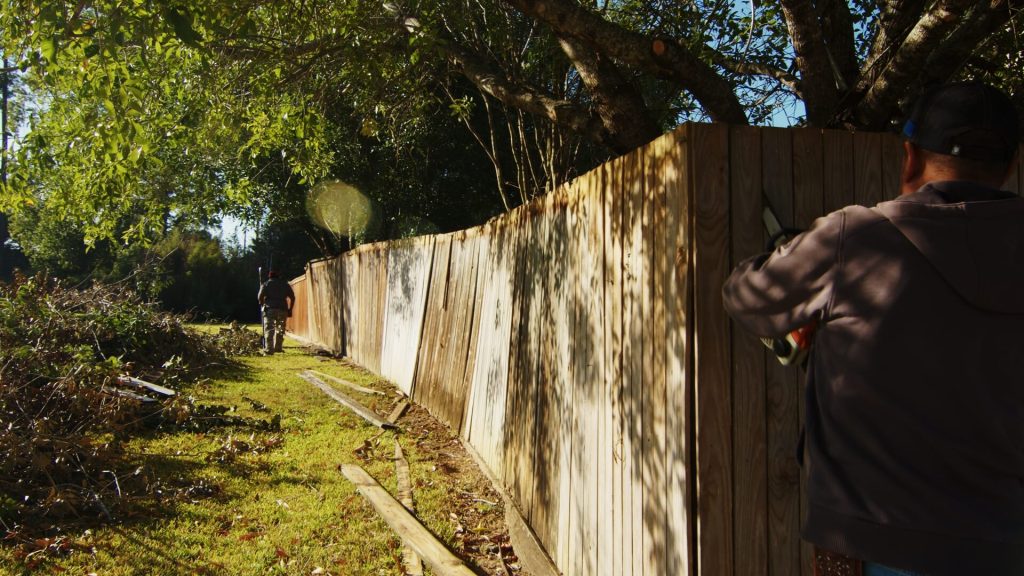Time to Replace Your Old Fence – Top 5 Signs
Did you know that the average wooden fence lasts between 10 to 15 years? We often overlook our fences until they become an eyesore or safety hazard. As homeowners, it’s important we recognize the signs that indicate it’s time to replace your old fence. From visible decay to structural instability, several factors can signal the end of your fence’s lifespan. Understanding these indicators not only helps maintain your property’s aesthetics but also secures the safety and security of your outdoor space. Let’s explore the key signs that suggest it might be time to replace your old fence.

Key Points
- Visible decay like rotting wood, splintering, or mold growth indicates the need for fence replacement.
- Structural instability, including leaning or sagging sections, compromises the fence’s integrity and security.
- Frequent repairs and maintenance become more costly than replacing the entire fence.
- Compromised privacy and security due to missing or damaged sections require immediate attention.
- An outdated appearance diminishes curb appeal and may not align with current home aesthetics.
Visible Decay and Damage
Numerous signs of visible decay and damage can indicate it’s time to replace your old fence. We should be attentive in identifying these visible signs to guarantee the structural integrity and aesthetic appeal of our property boundaries.
Rotting, splintering, and mold growth are clear indicators of decay that compromise the fence’s stability and appearance. Similarly, damaged sections, such as missing boards, holes, or leaning structures, signal the need for fence replacement. Investing in professional fence installation can secure that these issues are addressed with high-quality materials and craftsmanship, preventing future problems.
As responsible homeowners, we must address these issues promptly to prevent further deterioration and potential safety hazards. By conducting regular inspections and maintenance, we can catch early signs of decay and damage, allowing for timely replacement before the problems escalate. This proactive approach not only preserves the fence’s functionality but also maintains the overall beauty of our outdoor spaces.
Let’s remember that our fences serve as both protective barriers and aesthetic elements of our properties. By staying attentive to visible signs of decay and damage, we can secure that our fences continue to fulfill their purpose effectively, contributing to the safety and appeal of our homes and neighborhoods.
Structural Instability
Structural instability is an important issue that often means it is time to replace your old fence. When we notice our fence is leaning or sagging, it’s a clear indicator that the structure of the fence has been compromised. This instability typically stems from rotting posts and unstable foundations, which gradually weaken the entire fence system due to wear and tear over time. A leaning or sagging fence also detracts from the aesthetic appeal of our property, making it look neglected and rundown. Help you to know it’s time to replace your old fence.
Additionally, some styles like privacy fences are particularly prone to structural issues due to their solid panel construction.
We must recognize that a structurally unstable fence poses significant security and privacy risks. Our homes are our sanctuaries, and a compromised fence leaves us vulnerable. It’s important that we address these issues promptly to guarantee the safety of our property and loved ones.
In most cases, when structural instability becomes apparent, it’s time to replace your fence entirely. While repairs might seem appealing, they often provide only temporary solutions. A full replacement allows us to address the root causes of instability and choose a new fence style that meets our current needs. By knowing when it’s time to replace your old fence, we’re investing in long-term security and peace of mind.
Let’s not underestimate the significance of a stable fence in maintaining the integrity of our property boundaries and the safety of our community.
Frequent Repairs and Maintenance
As our fences age, the frequency of repairs and maintenance often increases, signaling that replacement may be necessary. We often find ourselves constantly fixing issues like decaying wood, twisted or fractured boards, and insecure fasteners. These telltale signs indicate a deteriorating fence that may need replacing soon.
Let’s consider the following table to understand the implications of frequent repairs:
| Repair Type | Short-Term Impact | Long-Term Impact | Replacement Benefit |
| Wood Decay | Temporary fix | Structural weakness | Enhanced durability |
| Missing Planks | Aesthetic improvement | Ongoing expense | Uniform appearance |
| Loose Attachments | Quick solution | Recurring problem | Improved stability |
| Paint/Stain | Visual enhancement | Regular maintenance | Low-maintenance option |
We’ve found that ongoing maintenance costs can add up, making a new fence more cost-effective in the long run. Investing in replacement eliminates the need for repeated repairs and guarantees long-term durability. It’s time to replace our old fence when we’re spending excessive time and money on upkeep. By recognizing these signs, we can make informed decisions about our when the time has come to replace your old fence.
Compromised Privacy and Security
With the passage of time, our once-sturdy fence may begin to fail in its primary duties of providing privacy and security. As property owners, we must remain vigilant for signs that our fence is no longer effectively safeguarding our space. Missing or damaged sections are clear indicators that it’s time to replace our old fence.
When holes or gaps appear, they compromise our privacy by allowing outsiders to peer into our property. These breaches in our perimeter not only expose our daily activities but also create vulnerabilities in our security measures. Broken or leaning fences further exacerbate these issues, as they can be easily breached by potential intruders.
Professional installation of a new fence not only restores security but also ensures proper configuration to manage access.
As responsible homeowners, we must prioritize maintaining a secure perimeter to protect our property and loved ones. When we notice these signs of compromised privacy and security, it’s essential to contemplate a new fence. Modern replacement fences offer enhanced features that address these concerns, providing us with improved protection and peace of mind. By recognizing these signs early and taking action, we guarantee our homes remain the safe havens we desire them to be.
Outdated Appearance and Style – Replace your Old Fence
Aesthetics play a crucial role in our home’s overall appeal. When it comes to our property’s exterior, an outdated fence can greatly diminish its curb appeal. If we notice that our wood fence looks worn, weathered, or simply out of style, it’s time to start considering a replacement.
Modern fence designs offer improved aesthetics and functionality, enhancing our home’s overall look and potentially increasing its value.
As homeowners, we should assess whether our current fence aligns with contemporary trends and meets our privacy and security needs. Old-fashioned styles may no longer provide the level of protection or visual appeal we desire. By upgrading to a more stylish design, such as Vinyl Fencing, we can significantly improve our property’s aesthetic while addressing practical concerns.
Replacing your fence isn’t just about maintaining appearances; it’s an investment in our home’s future. A new one can revitalize the entire exterior, creating a cohesive look that complements our property’s architecture and landscaping. When we notice our fence becoming an eyesore rather than an asset, it’s a clear sign that upgrading is necessary to preserve and enhance our home’s visual appeal and value.
Frequently Asked Questions
When to Replace your Old Fence?
We should replace our old fence when we notice decay, rust, or damage. Let’s look for leaning structures, missing boards, and privacy issues. We’ll also consider sun exposure, operational difficulties, and high maintenance needs as indicators for replacement.
How Many Years Should a Fence Last?
We typically expect fences to last 15-20 years, but it’s not a one-size-fits-all scenario. Depending on the material and our maintenance efforts, we can see lifespans ranging from 5-30 years. Let’s aim for longevity together!
When Should I Replace My Fence Panels?
We should replace our fence panels when we notice signs of rot, decay, or significant damage. Let’s also consider replacement if our panels are warped, cracked, or structurally unstable. Together, we’ll maintain our property’s security and aesthetic appeal.
How Do I Know if My Fence Is Rotting?
We’d love to ignore our fences, but we can’t. Let’s check for yellow or gray stains, accompanied by mold growth. We’ll focus on areas near the ground, where moisture lingers. Together, we’ll spot rot before it’s too late and know when it is time to replace your old fence.
The Takeaway
We’ve walked through the warning signs of a weathered, worn-out fence. From visible decay to structural instability, frequent fixes to fading functionality, it’s clear when to replace your old fence. By carefully considering these criteria, we can confidently conclude that replacing our rickety railings is the right choice. Let’s look forward to a fresh, fortified fence that fulfills our needs for privacy, protection, and pleasing aesthetics, ensuring our property’s prolonged appeal and security.








